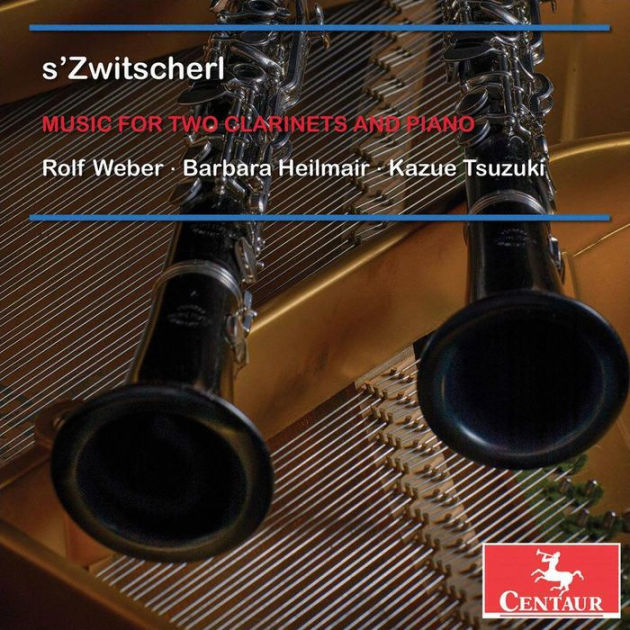 s’Zwitscherl - Music for Two Clarinets and Piano. 2020. Rolf Weber, clarinet; Barbara Heilmair, clarinet and bass clarinet; Kazue Tsuzuki, piano. Centaur Records, Inc. Contents: Divertimento No. 1 for Two Clarinets and Piano (Charles Camilleri), Duo Concertante Op. 23 (Iwan Müller), Duo Concertant, Op. 33 (Carl Baermann), Duo on Bellini’s La Sonnambula (Adolphe Leroy and Eugene Jancourt), Musica Masonica for Clarinet, Bass Clarinet, and Piano (Franck Adrian Holzkamp), Orfeo e Eurydice for Two Clarinets and Piano (Franck Adrian Holzkamp), s’Zwitscherl für Zwei (Franz Cibulka). www.centaurrecords.com, $17.99.
s’Zwitscherl - Music for Two Clarinets and Piano. 2020. Rolf Weber, clarinet; Barbara Heilmair, clarinet and bass clarinet; Kazue Tsuzuki, piano. Centaur Records, Inc. Contents: Divertimento No. 1 for Two Clarinets and Piano (Charles Camilleri), Duo Concertante Op. 23 (Iwan Müller), Duo Concertant, Op. 33 (Carl Baermann), Duo on Bellini’s La Sonnambula (Adolphe Leroy and Eugene Jancourt), Musica Masonica for Clarinet, Bass Clarinet, and Piano (Franck Adrian Holzkamp), Orfeo e Eurydice for Two Clarinets and Piano (Franck Adrian Holzkamp), s’Zwitscherl für Zwei (Franz Cibulka). www.centaurrecords.com, $17.99.
The ensemble s’Zwitscherl (Austrian dialect for “chatter” or “twitter”) is a trio of Swiss, German, and Japanese musicians who play a somewhat unusual combination of instruments: two clarinets and piano. A mix of compositions spanning two centuries await the listener on the trio’s new album. Contemporary works appear alongside Romantic-era compositions and arrangements, giving the listener a broad taste of music written for this unique instrumentation.
Twentieth-century Maltese composer Charles Camilleri draws from folk elements and the influence of Manuel de Falla in his Divertimento No. 1 for two clarinets and piano. Open harmonies, rhythmic dances, and lovely interwoven descending lines in the second movement make for a charming overall impression. Two “Duo Concertant” works follow, by Iwan Müller and Carl Baermann, composers known to modern clarinetists for their important contributions to the field in the nineteenth century. Following the formal and tonal norms of their time, these works present palatable alternatives to the oft-performed Concert Pieces by Felix Mendelssohn, balancing soloistic and supportive roles for the two solo voices. An operatic fantasy by Adolphe Leroy and Eugene Jancourt (arranged for the trio by Rolf Weber) also conforms to the traditional form of theme and variation. The showy, playful material provides an enjoyable listening experience, though a sense of restraint leaves the listener wishing for more flexibility in color and character and a feel of carefree spontaneity in the technical passages.
The album shifts gears with three more recent compositions: two by Franck Holzkamp and one by Franz Cibulka. Holzkamp’s Musica Masonica, written for the 200th anniversary of a Masonic lodge located in Saxony, “Zum helleuchtenden Stern” (“To the Bright Shining Star”) and later arranged for this trio instrumentation, achieves a celestial flavor. Intense, rich textures, thick chordal writing in the piano, the fresh sonority of bass clarinet, and the sheer volume sustained over time invoke the immensity and wonderment of stellar space. In contrast, Holzkamp’s take on Orfeo e Eurydice is delicate and contemplative.
Finishing the album is Cibulka’s s’Zwitcherl, originally written for solo clarinet and piano or accordion. This work utilizes energetic and playful elements to bring birdsong to life through wicked tremolos and virtuosic technical passages. The rhythmic drive, folk dance influence, and glissandi will bring a smile to the listener’s face. This piece deserves its place as the namesake for the album and the trio; the commitment and energy invested by the performers in this work is audible in their flexible rubato, the smoothly-handled transitions, and the impressively solid execution of the myriad tricky intervallic passages.
Although it may seem like niche repertoire, it is worth noting that clarinetists across the world are always on the lookout for pieces written for this instrumentation. This album gives performers and pedagogues alike a new awareness of a wide array of lesser-known choices. The polished presentation, balanced roles featuring virtuosic playing from every member of the trio, and a clear dedication to collaborative playing in matching sound, balance, and interpretation, make this album a worthwhile investment.


